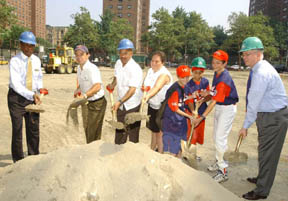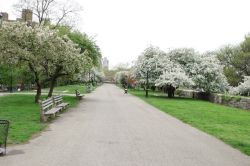Riverside Park
The Daily Plant : Tuesday, August 26, 2003
GROUND IS BROKEN ON NEW FIELD ON UPPER WEST SIDE

On Friday, August 22, an enthusiastic Council Member and Commissioner gathered with New Yorkers to celebrate the start of a project to create a new artificial turf field on Manhattan’s Upper West Side. Parks & Recreation Commissioner Adrian Benepe and Council Member Philip Reed led the ground breaking for Frederick Douglass Playground with $875,000 in funds allocated by the City Council.
Sitting next to a big dirt field, everyone gathered was imagining what the area will look like early next year. What was an asphalt ballfield is to be converted into a new multipurpose turf field, designed by Parks & Recreation’s Allan Scholl. Some of the field’s future patrons, children from the West Side Little League, joined in the festivities.
"With the installation of this field, this playground will become an even greater resource for the community—these fields are more durable than regular fields and can support constant play," said Commissioner Benepe. "We are lucky to live in a city where the Mayor and City Council value open space and public recreation. Because of their generous support of parks—even in tough economic times—we’ve been able to transform windy dust bowls into green, lush, state of the art fields."
Artificial turf fields, once considered uncomfortable and unsightly, are now being used increasingly in parks thanks to the revolutionary technological advances made in the material. The first artificial turf field used by Parks & Recreation was a carpet-style field in Manhattan’s Chelsea Park and the second was in Riverside Park. Recent parks to receive similar artificial turf fields include the Dyker Beach Park in Brooklyn and East River Park in Manhattan.
The playground’s namesake, Frederick Douglass was born in 1817 in Tuckahoe, Maryland. The son of a slave named Harriet Bailey, Frederick spent his early years on Aaron Anthony’s plantation. Following his master’s death, Frederick was sent to Anthony’s son-in-law Hugh Auld, who lived in Baltimore, Maryland. While in Baltimore, Frederick was introduced to reading and writing by other slaves. Although literacy among slaves was illegal, Frederick developed a passion for the written word and educated himself by reading abolitionist literature. In 1834, Auld sold Frederick to a rural farmer in Talbot County, Maryland, who was a notorious "slave-breaker." After four years of abuse and one unsuccessful escape attempt, Frederick managed to run away to New York City during 1838. Frederick viewed his escape as a rebirth and so changed his last name from Bailey to Douglass.
In 1838, Douglass married Anna Murray and the couple settled in New Bedford, Massachusetts, where he became involved in the African Methodist Episcopal Church. Within the congregation, Douglass preached abolitionism. In 1841, the renowned abolitionist William Lloyd Garrison witnessed Douglass deliver a riveting, heartfelt anti-slavery speech in Nantucket, Massachusetts. Garrison immediately enlisted Douglass as an abolitionist lecturer. By 1843 Douglass had become well known throughout the Northern United States for his fiery and credible oratory.
At Garrison’s urging, Douglass wrote an autobiography entitled Narrative of the Life of Frederick Douglass that was published in 1845. The publication proved to be a mixed blessing. Douglass continued to use writing as a way of spreading abolitionist messages. In 1847, he served as publisher for the abolitionist periodical North Star. Eight years later, he completed his second biography entitled My Bondage and My Freedom. During the 1850s, Douglass supported John Brown’s raid at Harper’s Ferry, Virginia, and backed Abraham Lincoln’s presidential bid. In 1872 he moved to Washington, D.C. Douglass completed his final work, The Life and Times of Frederick Douglass in 1892 and died in 1895.
QUOTATION FOR THE DAY
"I’ve taken my fun where I’ve found it."
Rudyard Kipling
(1865-1936)
Check out your park's Vital Signs
Clean & Safe
Green & Resilient
Empowered & Engaged Users
Share your feedback or learn more about how this park is part of a
Vital Park System

Know Before You Go
Related inquiries may be sent to boatbasin@parks.nyc.gov
Related inquiries may be sent to boatbasin@parks.nyc.gov


